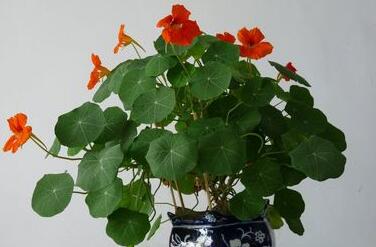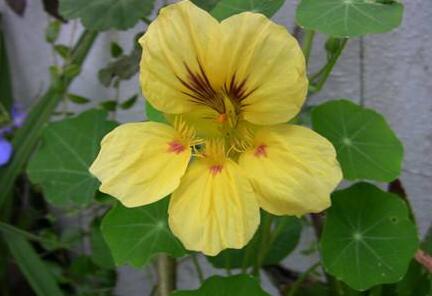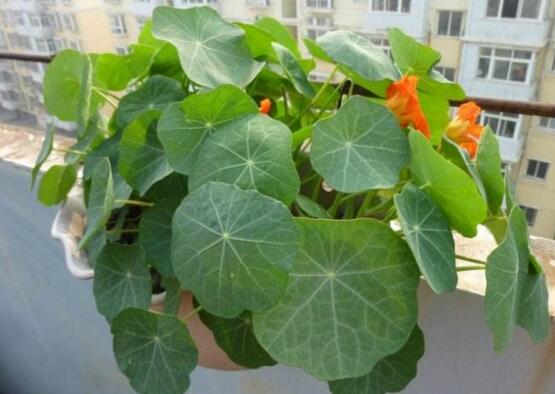How to change the pot and transplant, time and soil are very important / maintenance skills after transplanting
Because of its fast growth rate, it is relatively easy to burst pots, so it needs to change flowerpots and soil after a period of time, because it needs to adapt to the new potted soil environment after changing pots, in order to ensure that it can spend this period of time smoothly, you need some skills when transplanting, and how to change pots for transplanting? The editor came to tell you the main points of changing the basin.
In which month is it good to change the pots of Golden Lotus?

Changing the basin should avoid the time of high temperature and cold, so it is generally chosen to be carried out in April-May or September-October, when the temperature is suitable, and the plant can resume growth as soon as possible after changing the basin, which has the least impact on it. If the temperature of changing the basin is not controlled properly in winter, the plant is prone to frostbite.
How to change pots and transplant Clematis paniculata
1. Prepare soil and flowerpots
Four parts of rotten leaf soil, one part of compost soil, four parts of garden soil and one part of sandy soil can be mixed into culture soil, which is the most suitable in terms of air permeability, displacement and nutrient content. in addition, when changing the basin, we should also pay attention to the soil moisture of about 50%. Flowerpots should choose porous plastic pots or ceramic pots of the right size.
2. Take off the pot and replant
After preparing the soil and flowerpots, how to change the pots and transplant them? Remove the plant from the previous flowerpot, then remove the persistent soil from the root, replant it in the prepared flowerpot, and be careful not to fertilize or water at this time.
Points for attention in changing pots of Trollius paniculata
1. Watering. Keep the soil moisture at 50% before changing the basin, do not water immediately after changing the basin, need to slow the seedling period for 2-3 days, and then properly water after 2-3 days to keep the soil slightly moist, preferably by spraying water, do not overwater.
2. Fertilization. The soil that has just been replaced is very abundant in nutrients, so there is no need to apply fertilizer frequently. After it resumes its growth, it will begin to fertilize normally. The method can refer to the detailed description of how to apply fertilizer to Clematis paniculata, mainly phosphorus and potassium fertilizer and nitrogen fertilizer. Do not only apply nitrogen fertilizer, otherwise it is easy to grow steeply.
3. Light. Dry lotus is more like the sun, but after changing the basin can not be immediately placed in the sun, it is best to put in a bright place to maintain for a few days, wait until its leaves are still green and straight, and then slowly increase the light, if directly placed in the sun, it is easy to wilt the possibility of leaves.
4. Pruning. When the lotus is taken out of the flowerpot, its roots can also be trimmed properly, such as cutting off some old rotten roots, but attention should be paid to avoid injuring the roots in the process of pruning, otherwise it will affect the growth after transplanting.
How to change pots and transplant Clematis paniculata
The season of changing pots and transplanting Trollius
The pot-changing transplanting of Clematis should be carried out in the Spring and Autumn period. The temperature and humidity in spring and autumn are very suitable, and it is also the growing season for trollids, and it is easy to keep up with the growth after changing pots.
Points for attention in changing pots of Trollius paniculata
Basin soil: the humidity of basin soil for changing basin should be 50%. The soil should choose rich and loose sandy soil.
Temperature: on the day of basin change, 18-25 ℃ is the suitable temperature range. It is easy to frostbite if it is too cold and dry if it is too hot.
Maintenance of Clematis paniculata after changing basin
After changing the basin, the dry lotus is relatively fragile, and its growth is often not as good as that left in the original basin, so we should pay more attention to maintenance.
Watering should be carried out 2-3 days after changing the basin, the amount of water should not be too much, wet the basin soil and spray the leaves.
Fertilization should be half a month after changing the basin, phosphorus and potassium fertilizer is appropriate, it is best not to apply nitrogen fertilizer, otherwise it is easy to grow and burn the root system.
The stem of the plant that changes the pot is relatively fragile and tender, and it should be moved slowly, otherwise it is easy to break.
How to trim the dry lotus, the method / time and skill of topping are very important.
We know that Nelumbo nucifera has the characteristics of intertwining growth, if it is allowed to grow, its branches may be intertwined and appear messy, although this is its natural growth state, but it is not beautiful and affects the light transmittance between branches and leaves, so it needs to be pruned in time, so how to prune it? When will the golden lotus hit the top? Work with the editor to learn about the correct pruning method.
How to prune the dry golden lotus
When pruning the lotus, techniques such as topping, thinning and cutting are generally used, of which topping is the most critical, which can control the growth of the lotus so that it does not grow too high and too fast, while thinning is often carried out after the plant is grown up, which can keep the lotus more beautiful as a whole.
When will the golden lotus hit the top
Topping is also known as heart-picking, and it needs to be carried out from the time of the seedlings, usually when it grows 7-8 leaves, remove the buds at the top, and then let it continue to grow, and the whole seedling stage may be topped 1-3 times.
Although the removal of its buds at the seedling stage may seem to hinder the growth of the lotus, in fact it can promote the growth, it can make the lotus sprout more side branches, so that its overall plant height should not be too high, otherwise it may not be put indoors because of space problems.
Pruning method of Clematis paniculata
How to prune the dry lotus during the adult period? At this point, it needs to be thinned and truncated. Sparse shearing is to cut off part of its dense and messy branches; short cutting is to cut off the branches with scissors to prevent it from growing too fast horizontally.
In order to make the overall plant shape more beautiful, we also need to use a bracket or thread for traction to let it grow in the desired direction, so as to make it more beautiful at the same time. In addition, pruning and cutting may be used many times in the growth process, depending on plant growth and personal aesthetics.
Maintenance after pruning
1. After topping, there is no need to fertilize or water immediately. You can wait until it grows a few centimeters of new branches before replenishing fertilizer and water. In the seedling stage, when the plant grows to about 15 centimeters, it is best to set up a bracket and tie the main vine to the bracket with thread. It can make it reach the ideal shape after it grows into a plant.
2. Pruning at the adult stage can replenish a certain amount of water after pruning, but try to avoid sprinkling water on the cutting mouth. In addition, when changing pots and transplanting, the roots can also be trimmed, but only the extra fibrous roots can be cut off so as not to hurt the main roots.
- Prev

How to apply fertilizer and what fertilizer / nitrogen, phosphorus and potassium nutrition balance can be used in Golden Lotus?
Golden lotus is a favorite flowering plant for many people. Fertilization is a very important point in its growth process, which is related to whether the flower color is gorgeous, whether the number of flowers can be more, and so on. What kind of fertilizer can dry lotus use? The following editor will tell you the answer.
- Next

How to trim the dry lotus, the method / time and skill of topping are very important.
We know that Nelumbo nucifera has the characteristics of intertwining growth, and if it is allowed to grow, its branches may be intertwined and appear messy, although this is its natural growth state, but it is not beautiful and affects the light transmittance between branches and leaves, so it needs to be pruned in time.
Related
- Fuxing push coffee new agricultural production and marketing class: lack of small-scale processing plants
- Jujube rice field leisure farm deep ploughing Yilan for five years to create a space for organic food and play
- Nongyu Farm-A trial of organic papaya for brave women with advanced technology
- Four points for attention in the prevention and control of diseases and insect pests of edible fungi
- How to add nutrient solution to Edible Fungi
- Is there any good way to control edible fungus mites?
- Open Inoculation Technology of Edible Fungi
- Is there any clever way to use fertilizer for edible fungus in winter?
- What agents are used to kill the pathogens of edible fungi in the mushroom shed?
- Rapid drying of Edible Fungi

